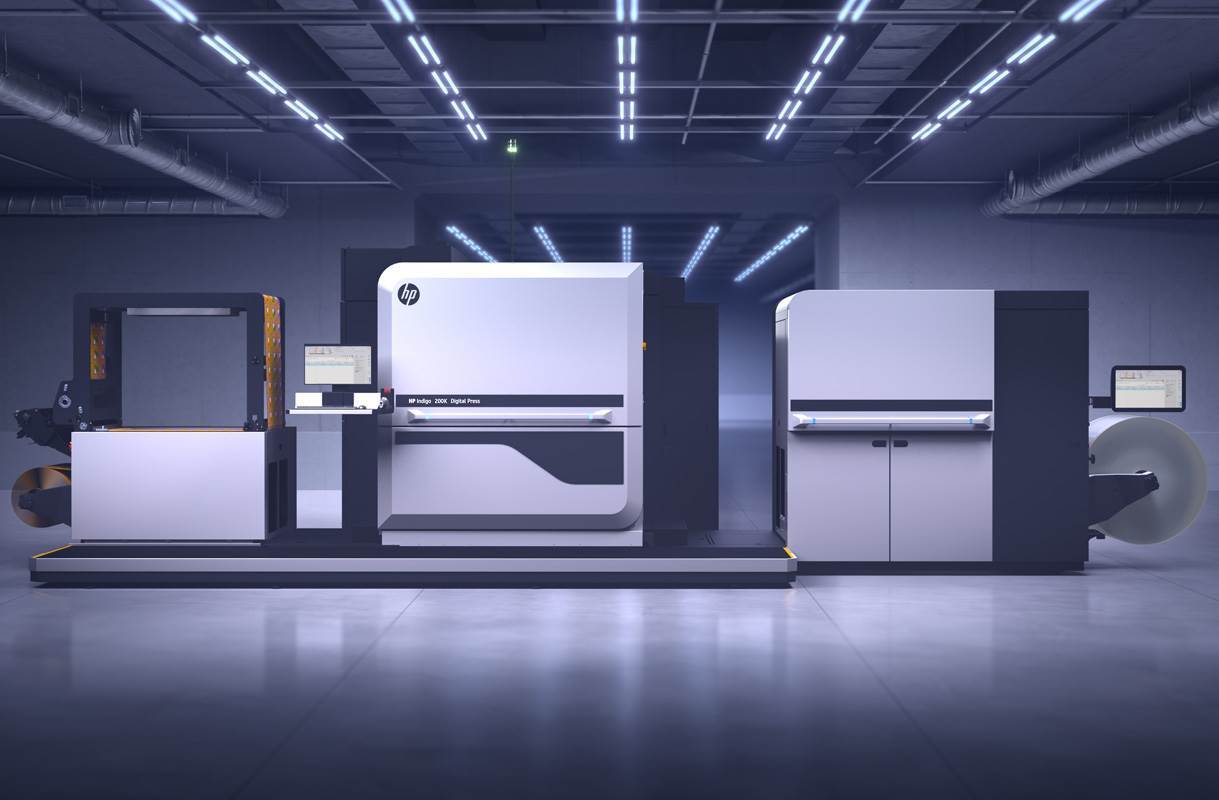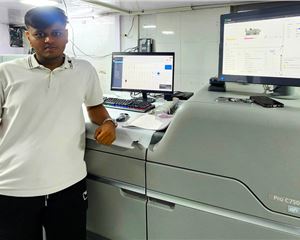Is consumer demand driving the growth of labels and packaging in India?
Eli Mahal, head of L&P products at HP Indigo, says that brands are increasingly producing shorter print runs with faster time-to-market due to consumer demands for convenience and personalisation. Mahal tells Noel D'Cunha why he believes digital adoption in India's label and packaging market will grow rapidly in the coming years
06 May 2024 | By Noel D'Cunha
Noel D’Cunha (NMD): What are the labels and packaging market trends?
Eli Mahal (EM): When it comes to labels and packaging, regardless of digital, we can see that the movement of population from rural areas into urban areas is driving the growth of packaging consumption per person. The correlation between GDP, urban populations, and middle-class size is also evident in the flexible packaging market. India's flexible packaging market size is around USD 12 billion, about 10% of the global flexible packaging market. However, the flexible packaging market per person in India is around USD nine or USD 10 of flexible packaging consumed per person in India versus around $50 in Germany. India's market size is relatively low compared to its population and will grow faster than other areas.
NMD: What portion of packaging products is digital among big brands?
EM: The answer varies depending on the type of packaging. The global average pressure-sensitive label produced digitally is close to 10%. In flexible packaging, the percentage is less than 1%, even in the US and Europe. Digital adoption in the label and packaging market is still in the early adoption phase. Due to positive market trends, the growth of digital print is much faster than the overall labels and packaging market.
Digital FP on over 300 Indigo presses grow 350% since 2017, this is x10 from the FP market growth.
NMD: What is driving the adoption of digital production in the label and packaging market?
EM: Consumers are driving the adoption of digital production in the label and packaging market. As consumers become more demanding for convenience and personalisation, brands need to deliver more SKU while keeping their level of obsolescence or waste in a relatively small number. Therefore, brands shift more production from longer runs produced conventionally into shorter runs with faster time to market that are produced digitally. This trend is particularly evident in countries like India, where the middle class is growing very fast.
NMD: But there are clear differences between countries when it comes to printing volume?
EM: Due to its size, India has a significantly higher volume of prints than other countries. There is a correlation between a country's GDP, size, and volume of prints. For instance, with high GDP, small countries like Holland tend to have a higher volume of digital prints per capita. On the other hand, large countries with smaller GDP, such as Brazil, may have a lower volume of digital print. This is the general correlation between digital print and the level of GDP and size of a country.
NMD: So, it’s a similar picture with the brands in India too?
EM: The small brands are the ones that are leading the way in consuming digital print. This is true not only in the story of India but in other countries as well. In every society, there are classes of people who are wealthier and living in cities. Many of these people prefer to shop for premium and sustainable products from smaller and local brands, and they are willing to pay more. They want the products to be more eco-friendly, and digitally printed labels or pouches are a great solution for them. For small and medium brands, conventional printing methods require compromise on minimum quantity, lengthy delivery and paying too much money for plates, digital printing offers a more sustainable and cost-effective solution.
NMD: In a recent presentation you made, you said that HP has seen a 70% growth in digital printing over the last seven years, which is significantly higher than the 10% market growth. Quite significant?
EM: We look at trends worldwide. Digital growth is significantly higher than the growth of the total market. This is driven by the trends that I just talked about. People want more personalisation and convenience, and they demand more variety from brands, which is leading to the high growth in the number of products available in the super market. This creates production complexity for converters, leading to moving jobs from conventional assets into digital assets.
NMD: You also mentioned about the famous breakeven point ratio of 10:90. So, when a new job comes into a factory, it will probably go to flexo, unless it's a short run. How long will this continue, in view of talks about everything going digital in the next ten to 20 years?
EM: Flexo and conventional printing equipment will continue to remain relevant for the next 20-30 years and won't become obsolete. However, as a provider of digital printing solutions, we have two trends that are working in our favour. Firstly, the market is shifting towards shorter print runs, faster delivery, and more SKU, which is the sweet spot for digital printing. This trend is benefiting us globally. Secondly, as a company, we are focusing on developing sustainable products with lower total cost of ownership (TCO). We are investing heavily in providing our customers with more productive and cost-effective solutions.
NMD: Can you explain?
EM: On the one hand, jobs are moving from the long run to the medium and short run. On the other hand, digital printing is becoming more economical in terms of printing longer runs. This trend is leading to significant growth in digitally printed labels and packaging, which is much bigger than the growth of conventional print. While conventional printing will not disappear in the next 20 or 30 years, the percentage of digital flexible packaging (currently at 1%) and label printing (currently at 10%) will likely to change significantly.
NMD: Eli, you also mentioned flexible packaging and digital printing, which saw 135% growth and reached 1 billion. But you have a competition coming from CI flexo. Around 15 imported machines are installed in India annually.
EM: The flexible packaging industry is predominantly dominated by CI flexo due to its speed and width. However, the plates can be expensive for smaller and medium-sized brands that want to produce several SKUs for a specific product. These brands may find it challenging to start with a CI flexo since they would have to pay thousands of dollars for the plates and buy much more than what they need, resulting in higher printing costs. As a result, they may opt for lower-quality packaging, such as a clear pouch with a label on top of it.

HP Indigo 25K Digital press
NMD: So, you are saying that digitally printed flexo packaging is the best option for, say, SME brands that want world-class packaging at a reasonable price?
EM: Yes, for the needs of these customers, It is a better alternative to CI flexo. From the converter's perspective, owning a digital print also benefits their economy. CI flexo is like a Porsche car that runs fast on the highway. It won't perform better than a Honda in a crowded city. Bringing short-run and fast delivery jobs from CI flexo into a digital asset significantly increases the print time and utilisation of CI flexo.
Therefore, CI flexo and digital complement each other, where customers can print the right job at the right price. It's not so much a competition as it is complementary.
NMD: How short is the short-run? Can you print just one pouch with flexible packaging?
EM: I will split this into the label and flexible packaging runs. Short runs are typically one or two linear kilometres, depending on the job and the media's cost. Labels tend to have more volume under this economic break as they are smaller than pouches. Flexible packaging runs are usually more than ten or fifteen thousand square metres. The breakeven point is typically around two to three square kilometres.
However, our customers often print more than 40% of the volume above this break-even number due to factors such as quick delivery or a large number of SKUs. For instance, they may order ten kilometres with ten SKUs, each with a few hundred metres. Printing ten SKUs of ten kilometres on the digital asset is easy. In contrast, printing on a CI flexo is more challenging and costly as each SKU has different colours and requires changing some plates.
NMD: Why should the print and packaging invest in digital?
EM: Many converters recognise the benefits of digital printing, which enables them to be more efficient and expand their business beyond the current market. As a result, more and more converters are investing in digital assets. The decision often comes down to choosing between Indigo HP technology (LEP) or a UV inkjet, each with its pros and cons.
NMD: Drupa will see eight new machine launches from HP Indigo. Which of these are ideal for print and packaging converters, and how? Let’s begin with the HP Indigo 200K.
EM: In the flexible packaging market, HP Indigo 200K is a new product that follows the success of HP Indigo 25K, which sold over 350 presses. The new model is faster and more productive, and we installed over 30 presses.
To showcase the digital pouch factory ecosystem's full potential, HP Indigo will focus on flexible packaging, demonstrating the printing of roll stock and pouches with Indigo technology and its partners. LEP has no digital competition in flexible packaging, UV inkjet is not viable due to food safety regulations, and water-based inkjet still requires further development to be ready for the market.
NMD: And for the label market?
EM: HP Indigo offers three solutions for short runs and high versatility. HP Indigo 6K is the most popular product, with nearly 3,000 presses sold since its launch twelve years ago. HP Indigo V12 primarily targets medium and large players who want to print large volumes and replace flexo. This product can replace more than two flexo presses and reduce printing costs by 15-20%.
HP Indigo 200K is a wider format that is primarily for flexible packaging but can also be used for bigger labels, such as paint labels and shrink sleeves.

HP Indigo 200K Digital press
NMD: Can you explain why you say, the V12 Digital Press is a game changer?
EM: The V12 digital press is a game changer because it can print at 120 meters per minute with high quality and versatility while allowing for lower-cost printing due to the lack of plates and fast set-up time. Additionally, it offers increased agility and value for customers, allowing for faster delivery times, more SKUs, and the ability to add variable data.
NMD: Critics say the V12 has had several launches since 2020. Why?
EM: The V12 is a complex project, and in 2020, HP announced that it is working on the V12 press that would be launched in 2021 or 2022. However, Covid-19 made things more complex in terms of supply chain and development, causing some delays. However, we were able to start beta testing in the second half of 2022. We currently have seven V12 running in the field, and some of our customers are in the final stages of buying a second or third press. Our plan is to release the product to relevant customers at Drupa.
NMD: We are often asked what the difference is between LEP and LEPx.
EM: LEP is a central impression press that runs at 120 meters per minute, but the speed is reduced when more colours are used. LEPx, on the other hand, has a serial architecture with six engines and 12 colours, allowing for more speed and production flexibility. The writing head is also different, with LEPx using LED instead of laser for higher definition and fewer moving parts. Overall, LEPx is designed for higher volume printing than LEP.
NMD: Will the LEPx only be for the V12 machines, or is it also available for other machines?
EM: LEPx is a new architecture being used in the V12 product for the label market. However, the technology is being explored for use in other products and formats and to serve more segments. The number of engines can also be adjusted depending on the product. For example, there can be fewer engines for a smaller product or wider engines for a wider format.
NMD: What is the final output speed of the machine?
EM: The machine's output speed at the printer's end is constant at 120 meters per minute for up to six colours. This speed is suitable for most jobs.
NMD: Why has HP never gone the other way, like hybrid machines mixing digital with flexo?
EM: In the digital print market, Indigo technology LEP or LEPx covers around 60%, while other toner technologies like Konica Minolta or Xeikon make up nearly 10%. The remaining 30% is UV inkjet; most UV inkjets are sold as stand-alone.
About 5% of the presses sold today are hybrid, which combines digital printing with conventional finishing or flexo stations. These presses are suitable for bigger converters specialising in a specific area, such as personal care, printing shampoos with metallic colours and other embellishments.
For generalist label players who serve multiple verticals, hybrid presses are not productive as they require frequent setup changes, which can decrease productivity.

NMD: If you had to discuss automation in the Indian labels and packaging markets, where would you start?
EM: Automation is a big word, right? Digital printing is a significant step towards automation compared to traditional methods flexography. It saves time and effort as it doesn't require plates or mixing ink. Additionally, using JDF to move data of job properties to the system is another automation improvement. Robotics is also a way of automation, but in India, labour is relatively cheap. Thus, the ROI of robotics may be more lengthy.
NMD: Can you explain?
EM: In the Western market, we recently conducted a market survey in the US, revealing that the flexo industry's number one challenge is the labour shortage. Recruitment is time-consuming, and attracting people to work for flexo is difficult. Robotics can replace manual labour, significantly reducing costs, especially when moving pallets and jobs between production and warehousing units. This business case is more effective in the West due to the high labour cost, while it may take longer to implement in India, where labour is relatively available at a lower cost.
NMD: How would you measure success in the labels and packaging industry?
EM: Success can be measured in different ways, such as growth, profitability, and OEE (overall equipment effectiveness). Digital printing has been shown to drive growth in the industry, but profitability can be more complex to measure since access to customer data is limited.
NMD: How does digital printing drive growth?
EM: Digital printing can drive growth by allowing converters to be more competitive, for example, by offering on-demand delivery, the freedom to add more SKUs, the ability to respond fast to art changes, the ability to add variable data, and more. It also generates 50% more revenue per square meter compared to conventional printing. The awareness of digital in the market is echoed by the great groundwork of our channel partners like Redington and TechNova, who help our customers with all aspects, from operational and logistics to business developments and marketing needs that meet the local market's unique needs.
NMD: What is the ideal scenario for a converter to be conventional, conventional, digital, or purely digital?
EM: Most converters mix of flexo and digital. They start with flexo and then add digital to their operations. However, there are converters that are purely digital, mainly new companies that decide to build a fully digital business or during generation change in a family-owned business. Trigon Digital, an HP Indigo 25K user, decided to print labels and flexible packaging digitally and use a local version of a fully digital pouch factory to serve SME brands with on-demand sustainable pouch offerings. Other established players like Janus International are building digital capabilities and dedicated business models to complement their conventional assets.
NMD: How can the printing industry change the public perception that it doesn't participate in eco talk and doesn't care for the earth?
EM: The industry can change this perception by reducing waste, obsolescence, and setup. Digital print can significantly reduce media consumption by reducing setup waste and allowing just-in-time and on-demand delivery. By consuming less media, the industry can make the biggest impact. In addition, converters should work with brands to adopt more sustainable media, such as recyclable, recycled or compostable.
NMD: What is the most important idea for the printing industry to tackle sustainability?
EM: The most important idea is to reduce waste, obsolescence, and set-up. Shifting from flexo to digital can reduce setup waste by 80-90%, and allowing just-in-time and on-demand delivery can reduce obsolescence. By consuming less media, the industry can make the biggest impact.












 See All
See All